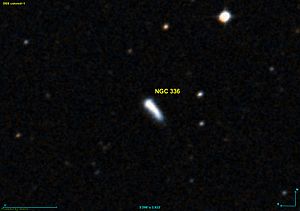NGC 336
| Galaxy NGC 336 |
|
|---|---|

|
|
| AladinLite | |
| Constellation | whale |
|
Position equinox : J2000.0 , epoch : J2000.0 |
|
| Right ascension | 00 h 58 m 02.8 s |
| declination | -18 ° 23 ′ 04 ″ |
| Appearance | |
| Morphological type | S / P / HII |
| Brightness (visual) | 14.7 mag |
| Brightness (B-band) | 15.5 mag |
| Angular expansion | 0.6 ′ × 0.2 ′ |
| Position angle | 41 ° |
| Surface brightness | 12.2 mag / arcmin² |
| Physical data | |
| Redshift | 0.018349 ± 0.000150 |
| Radial velocity | 5501 ± 45 km / s |
|
Stroke distance v rad / H 0 |
(247 ± 17) · 10 6 ly (75.6 ± 5.3) Mpc |
| history | |
| discovery | Francis P. Leavenworth |
| Discovery date | October 31, 1885 |
| Catalog names | |
| NGC 336 • PGC 3470 • ESO 541-002 • IRAS 00555-1839 • KUG 0055-186 • 2MASX J00580282-1823032 • NVSS J005802-182302 | |
NGC 336 is an irregular galaxy with extensive star formation regions of the Hubble type IB? in the constellation whale south of the ecliptic . It is an estimated 247 million light years from the Milky Way and about 45,000 light years across.
In the same area of the sky is u. a. the galaxy NGC 335 .
The object was discovered on October 31, 1885 by the American astronomer Francis Preserved Leavenworth .
